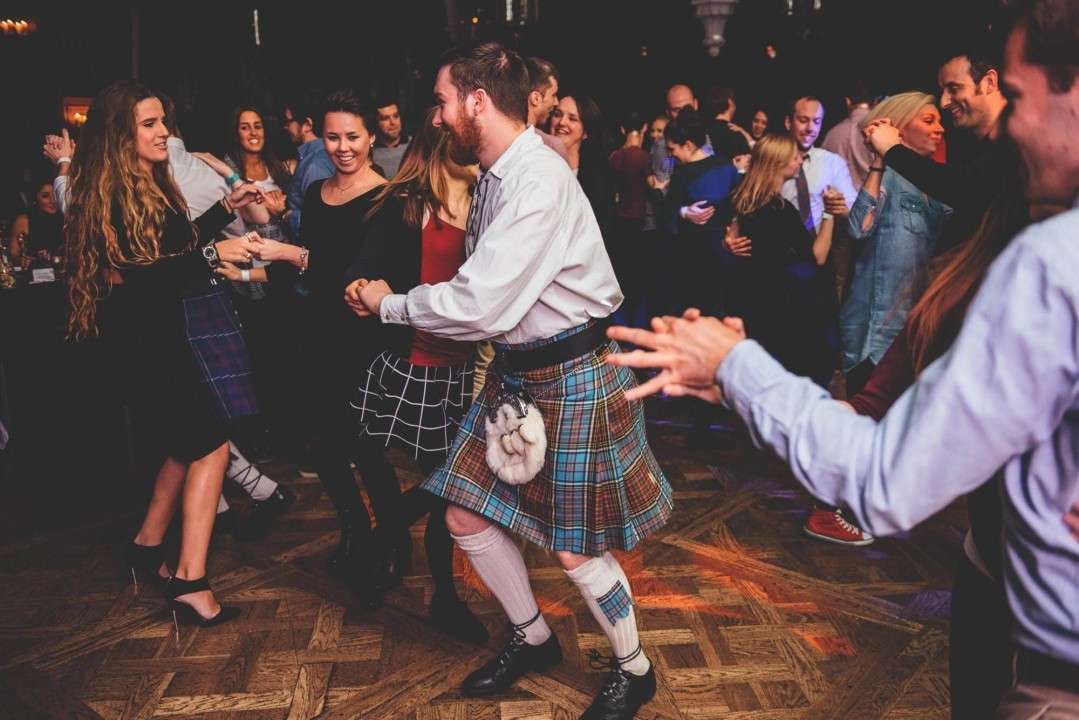Kilts whirling like dervishes, a tireless cascade of notes pouring from fiddles and pipes, and a mass of merry dancers moving as one – this is the quintessential modern ceilidh experience. However, much has changed in just a few centuries. If a time traveller from the 17thcentury Highlands found themselves attending a Hogmanay ceilidh today, they would not recognise the breathless scene before them. So, what are the origins of the ceilidh?
Ceilidh’s as we know them originated in the 19th century amid a flourishing of Gaelic romanticism and civic clubs who revelled in communal dances. It was also a time when previously distinct dance and musical traditions were being blended together to create new genres, with ceilidhs formed from a fusion of Irish, Scottish, English, and Scandinavian folk traditions. The predictability of standard dances such as Strip the Willow, Dashing White Sergeant, and The Flying Scotsman helped everyone to take part and know what to expect. This marks one of the key differences between modern ceilidhs and their progenitors: spontaneity. Ceilidhs of old were organic, unorganised affairs, often prompted by the arrival of an out-of-town visitor or the unexpected but welcome creaking open of the front door at the end of a hard day’s work. They were held in homes, not halls, and no evening of festivities was the same as another. It was, certain social conventions aside, a very informal affair. There might be thirty attendees or just a handful, the latter being no less a ceilidh than the former.
Storytelling
A ceilidh of this kind may have involved music and dancing if a skilled player was present, but the crux of it was storytelling. Stories centred on Ossian and the Fianna were especially welcome. Until the end of the 19th century in Glen Lyon, any traveller who sought shelter among the homesteads of the glen would first be asked, “Bheil dad agad air na Fiann?” (“Can you speak of the days of Fionn?”). If the visitor answered in the affirmative then others from the community would be gathered to enjoy a long evening of stories, as well as to compare notes on different versions of well-known tales. If such a stranger called, the patriarch of the house would tell the first tale and the visitor was expected to regale the hosts well into the wee hours. If no guest was present and a ceilidh had come together naturally, it would usually wrap up around midnight.
Education and intergenerational bonding were an important part of any ceilidh. News would be shared, crafts and tasks would be done around the fringes of the peat fire, and youngsters especially were encouraged to test their wits with riddles and recitations. If one child did especially well, they would be granted the title of Righ nan Tòimhseachan, the King (or Queen) of the Riddles. All benefitted from observing the skills of their elders, whether in the art of the story or of weaving and mending.
Homes in the Scottish Highlands and Islands were not the locked-up private domiciles that they are today, and the initiation of a ceilidh began not with a knock at the door but with someone sauntering straight in. One source from the Outer Hebrides recalls how, “doors were never closed except to an inhospitable wind.” As for the proceedings themselves, “There were no formalities and no programmes. The events of the evening were spontaneous, unpremeditated and unrehearsed.”
Coming together

Aspects of everyday life quite naturally became a part of the ceilidh’s set dressing. The smoky reek of a peat fire was considered a mandatory element, not only to heat and light the room but to provide suitable ambience. The sounds of livestock, most often black cattle, were ever-present, especially in the winter months when they were often kept in a subdivided section within the home. In the long dark of winter when it is pitch black by mid-afternoon and outdoor labour is difficult and dangerous, ceilidhs provided much-needed entertainment and uplifting to individuals and communities alike. They still do.
Ceilidhs could also be held as part of religious festivals. One such festival was the Latha Feille Brighde, the Feast of St Bridgid, held in Barra on February 1st. Once an annual event formally marked by the community, it fell out of fashion through the late 19th and 20th centuries. For the first time in a very long while in 2010, the feast was revived by Comunn Eachdraidh Bharraidh agus Bhatarsaigh (Barra and Vatersay Heritage Society) at the Dualchas (heritage centre) in Castlebay.
A figure of St Bridgid was made from corn sheathes and adorned by girls and women with clothing of seashells, primroses, crystals, snowdrops, and leaves. Entry to the heritage centre – a substitute for the blackhouses of old – was granted to the bearers of the figure, who chanted, “Brighde bhoideach oigh nam mile beus” (“Beautiful Bridgid, virgin of a thousand virtues”). Moving around the room in a circle, the girls held up the figure as people added adornments to it. It was then placed in a special bed, heralding the first day of Spring. Blessings were given, followed by a recitation of St Bridgid’s genealogy and the ritual tasting of the bannock. This may not sound like any ceilidh you recognise, but its participants very much described it as one. The modern ceilidh may seem far from these origins, yet remains consistent in spirit. In English, ‘ceilidh’ literally means ‘gathering’. Coming together with family and the community to bond, reminisce, sing and dance, and feel lifeful – especially at the coldest, darkest time of year – is the ceilidh’s true meaning.
Text by: David C. Weinczok.

